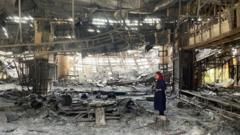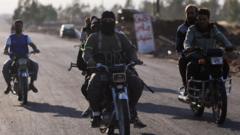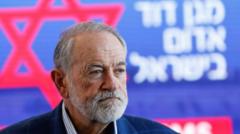Tehran, Iran is witnessing a fragile return to normalcy as the city struggles to recover from a brutal conflict, leaving its residents with deep emotional scars.
Life in Post-Conflict Tehran: Resilience Amidst Uncertainty

Life in Post-Conflict Tehran: Resilience Amidst Uncertainty
As Tehran emerges from a recent wave of conflict, residents grapple with fear and hope for a better future.
In the vibrant center of Tehran, the Boof cafe contrasts starkly with the city's recent turmoil. This establishment, nestled within the historic grounds of the shuttered US embassy, now serves refreshing iced drinks while echoing sentiments of hope for improved US-Iran relations. Barista Amir reflects the collective frustration, expressing how US sanctions impact local businesses and travel. Sparse patronage highlights the juxtaposition of Tehran's traditional lifestyle against the backdrop of emerging concerns over safety and political tensions.
The backdrop of political distress looms heavily, especially following a recent speech by Supreme Leader Ayatollah Ali Khamenei, who portrayed a stark view of Iranian-American relations. His remarks came on the heels of intensified Israeli strikes targeting Iran, resulting in significant casualties, including reports of over 600 fatalities and thousands injured. The emotional impact of these events ripples through the medical community, as exemplified by head nurse Ashraf Barghi's harrowing experiences treating injuries far worse than those seen during the Iran-Iraq war.
As life tentatively resumes—traffic fills the streets and bazaars open—there is a palpable sense of apprehension among residents. Many, like young Mina, express heartbreak and despair, grappling with feelings of hopelessness amidst efforts for a brighter future. The city's efforts to unite through culture and music, exemplified by a concert at the iconic Azadi Tower, provide a temporary respite for the community as citizens, both supporters and critics of the regime, come together.
Despite the oppressive political environment, Tehran's residents remain vocal, seeking greater freedoms and expressing their complexities in the face of uncertainty. Iranians, with their indomitable spirit, await what comes next from their leaders, both domestically and in the international arena.
The backdrop of political distress looms heavily, especially following a recent speech by Supreme Leader Ayatollah Ali Khamenei, who portrayed a stark view of Iranian-American relations. His remarks came on the heels of intensified Israeli strikes targeting Iran, resulting in significant casualties, including reports of over 600 fatalities and thousands injured. The emotional impact of these events ripples through the medical community, as exemplified by head nurse Ashraf Barghi's harrowing experiences treating injuries far worse than those seen during the Iran-Iraq war.
As life tentatively resumes—traffic fills the streets and bazaars open—there is a palpable sense of apprehension among residents. Many, like young Mina, express heartbreak and despair, grappling with feelings of hopelessness amidst efforts for a brighter future. The city's efforts to unite through culture and music, exemplified by a concert at the iconic Azadi Tower, provide a temporary respite for the community as citizens, both supporters and critics of the regime, come together.
Despite the oppressive political environment, Tehran's residents remain vocal, seeking greater freedoms and expressing their complexities in the face of uncertainty. Iranians, with their indomitable spirit, await what comes next from their leaders, both domestically and in the international arena.





















